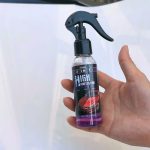I. Methods for Washing Car Seat Covers
A. General Tips for Cleaning Car Seat Covers
When it comes to cleaning car seat covers, it’s important to understand the material they are made of and check the care instructions provided by the manufacturer. Different materials may require different cleaning methods to ensure that the seat covers are not damaged during the process.
Firstly, take a good look at the seat covers and determine the type of material they are made from. Common materials include cloth, leather, vinyl, or synthetic fabrics. Natural materials like leather may require specific care, while synthetic fabrics or vinyl may be more tolerant of different cleaning methods.
Once the material is identified, refer to the care instructions provided with the seat covers. These instructions will guide you on the proper cleaning technique, water temperature, and any specific products or chemicals to avoid. Adhering to the manufacturer’s instructions can help maintain the quality and appearance of the seat covers.
Before starting the cleaning process, it is recommended to remove any excess dirt, crumbs, or debris from the seat covers. Use a vacuum cleaner with a brush attachment to gently suction away loose particles. For stubborn dirt or pet hair, a lint roller or a piece of sticky tape can be used to lift them off the surface.

B. Hand Washing Car Seat Covers
If your car seat covers are suitable for hand washing, this method can be an effective and safe way to clean them. Here’s how to go about it:
Preparing a gentle cleaning solution and a soft-bristled brush
Fill a basin or sink with lukewarm water and add a mild detergent suitable for the material of your car seat covers. Mix the detergent into the water until it forms a soapy solution. It’s important to use gentle, non-abrasive detergents to avoid damaging the material.
Next, obtain a soft-bristled brush, such as a vegetable brush or a toothbrush. Make sure the brush is clean and free from any residue or debris that could transfer onto the seat covers.
Gently scrubbing the seat covers and allowing them to air dry
Dip the soft-bristled brush into the soapy solution and gently scrub the seat covers in a circular motion. Pay extra attention to any stained or soiled areas, using gentle pressure to avoid damaging the material.
After scrubbing, rinse the seat covers thoroughly with clean water to remove all traces of soap. It’s essential to remove all soap residue to prevent it from attracting dirt and causing discoloration or damage to the fabric.
Once the rinsing is complete, shake off any excess water from the seat covers. Avoid wringing or twisting them, as this can lead to stretching or deformities in the material.
Finally, hang the seat covers to air dry in a well-ventilated area away from direct sunlight or heat sources. Make sure the covers are fully dry before placing them back in the car to prevent the growth of mold or mildew.

C. Machine Washing Car Seat Covers
If your car seat covers are machine washable, this can be a convenient and efficient way to clean them. Follow these steps for machine washing:
Pre-treating stains and heavily soiled areas
Before placing the seat covers in the washing machine, it’s important to pre-treat any visible stains or heavily soiled areas. This can be done by applying a small amount of mild detergent or stain remover directly to the affected areas. Gently rub or dab the detergent into the material, allowing it to sit for a few minutes to loosen the stains.
Selecting the appropriate wash cycle and using a mild detergent
Next, check the manufacturer’s instructions for recommendations on the suitable wash cycle and water temperature. If there are no specific instructions, a gentle or delicate cycle with cold or lukewarm water is usually safe for most car seat covers. Using hot water can cause shrinkage or damage to certain materials, so it’s best to avoid it unless specified otherwise.
When it comes to selecting a detergent, choose a mild and non-abrasive option to protect the integrity of the seat covers. Stay away from bleach or harsh chemicals that can fade or damage the material.
Place the seat covers in the washing machine, taking care not to overload the machine. Overcrowding can prevent proper cleaning and rinsing of the covers. If necessary, wash the seat covers separately or in batches to maintain the quality of the cleaning process.
Once the wash cycle is complete, remove the seat covers from the machine promptly. If the seat covers are suitable for tumble drying, place them in the dryer on a low heat setting to complete the drying process. However, if the manufacturer recommends air drying, follow the appropriate air drying steps mentioned earlier.

D. Dry Cleaning Car Seat Covers
Some car seat covers, especially those made of delicate materials like wool or suede, may require professional dry cleaning to maintain their appearance and integrity. Here’s what to consider when it comes to dry cleaning:
Identifying when dry cleaning is the best option
If the care instructions of your car seat covers specify that they should be dry cleaned, it’s important to follow these recommendations. Dry cleaning may be necessary for certain materials that are not suitable for water-based cleaning methods. Additionally, if the seat covers have intricate designs, embellishments, or are part of a more complex upholstery system, dry cleaning may be the safest option to ensure their integrity.
Choosing a professional and trustworthy dry cleaner for the task
When it comes to dry cleaning car seat covers, it’s crucial to select a reputable and experienced professional who specializes in cleaning delicate fabrics. Proper communication of the material and any specific stains or issues will help ensure the seat covers are treated appropriately and returned in excellent condition.
It’s important to note that DIY dry cleaning kits may not be suitable for car seat covers, as they may not provide the level of care and expertise that a professional dry cleaner can offer. The chemicals and procedures used in professional dry cleaning are specifically tailored to the needs of different materials, ensuring a safe and thorough cleaning process.
II. Maintaining the Quality of Car Seat Covers
A. Proper Storage and Handling of Seat Covers
Ensuring that your car seat covers are stored and handled appropriately is essential for maintaining their quality and prolonging their lifespan.
Storing seat covers in a clean and dry environment
When car seat covers are not in use, they should be stored in a clean and dry environment. This helps prevent the growth of mold, mildew, or unpleasant odors. It’s best to store seat covers in a breathable storage bag or container to protect them from dust and light. Avoid placing heavy items on top of the covers, as this can lead to creasing or deformation of the material.
If the seat covers are removed for seasonal use or temporarily, ensure they are stored in a location that is well-ventilated and free from extreme temperatures. Direct sunlight, excessive humidity, or damp conditions can be detrimental to the material and may cause discoloration or deterioration.
Handling the covers with care to prevent damage or stretching
Whether during installation, removal, or cleaning, it’s important to handle seat covers with care to avoid damage or stretching. When handling the covers, be mindful of any sharp objects or jewelry that may snag or tear the material. Careful handling helps maintain the shape, elasticity, and appearance of the covers, extending their lifespan.
Avoid pulling or tugging excessively when fitting the seat covers onto the seats, as this can lead to stretching or tearing, especially with elasticated materials. Follow the installation instructions provided by the manufacturer to ensure a proper and secure fit without causing unnecessary strain on the covers.

B. Regular Maintenance and Spot Cleaning
Regular maintenance and spot cleaning are essential for keeping car seat covers clean and well-maintained. By implementing these practices, you can prevent excessive dirt buildup and tackle stains promptly, preserving the appearance and integrity of the covers.
Implementing routine cleaning and spot treatments to avoid excessive dirt buildup
Incorporating a routine cleaning schedule for car seat covers is a proactive way to prevent excessive dirt buildup. Depending on usage and exposure to elements, a monthly or quarterly cleaning regimen may be suitable. Regular maintenance helps remove surface dirt and debris that can accumulate over time.
Spot treatments for stains and spills should be addressed promptly. When a spill occurs, use a clean cloth or paper towel to blot the liquid and absorb as much of it as possible. Avoid rubbing the spill, as this can spread the stain and work it deeper into the fabric. Once the excess liquid is removed, follow the specific spot cleaning method recommended for the material of the seat covers.
Using gentle cleaning methods and avoiding harsh chemicals or excessive heat
When it comes to spot cleaning, it’s crucial to use gentle methods and products to protect the material of the seat covers. For cloth seat covers, a mixture of mild detergent and water can be used for spot cleaning. Alternatively, specialized fabric cleaners specifically formulated for the material can be utilized. Test any cleaning products on a small, inconspicuous area of the seat covers to ensure they do not cause discoloration or damage.
For leather or vinyl seat covers, use cleaners and conditioners that are designed specifically for these materials. Avoid using abrasive brushes or rough materials that can scratch the surface or cause premature wear. After cleaning, ensure the seat covers are completely dry before use to prevent water stains or mold growth.


